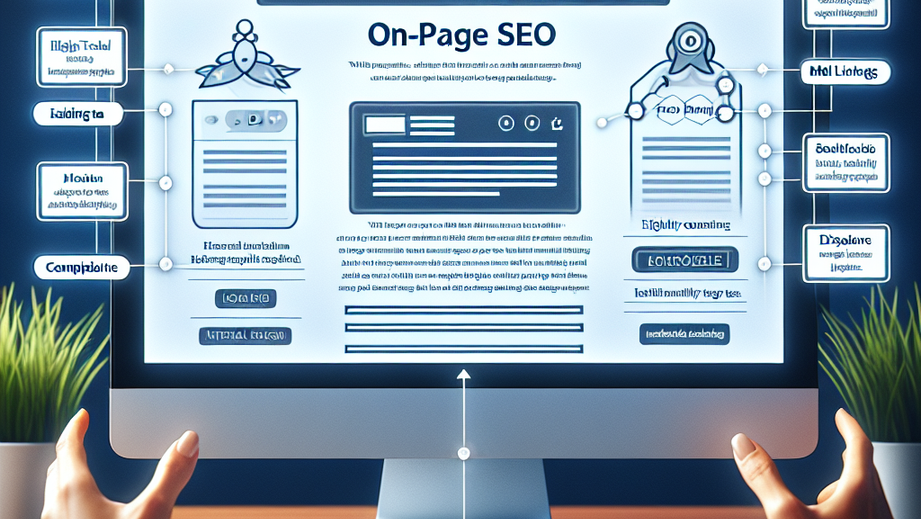In the fast-changing world of digital marketing, on-page optimization plays a crucial role in achieving success. This practice involves improving a webpage’s visibility and ranking in search engine results by optimizing various elements, including HTML code, content, and design. By doing so, businesses can strengthen their online presence and attract more organic traffic. In this article, we will explore the strategies and best practices that can take your on-page optimization efforts to new heights.
The Importance of an Engaging Title Tag
The first step in on-page optimization is creating a concise and compelling title tag. This tag must accurately describe the webpage’s content while incorporating the main keyword. Following the recommended character limit is important to ensure optimal visibility in search engine results. A well-crafted title tag can make a significant difference in capturing the attention of potential visitors.
Engage with a Concise Meta Description
Equally important is the meta description, which provides a brief summary of the webpage’s content. By including relevant keywords in the meta description, businesses can entice users to click through and explore their website further. Crafting an informative and engaging meta description is vital in capturing the attention of potential visitors. Make it irresistible!
Utilize the Power of Keywords
Thorough keyword research is a significant aspect of on-page optimization. By identifying relevant keywords, businesses can gain valuable insights into what their target audience is searching for. Naturally incorporating these keywords into the title tag, headings, meta description, and content helps enhance the webpage’s relevance and visibility in search engine results. Speak the language your audience wants to hear.
Heading Tags: Guide Readers and Search Engines
Heading tags, such as H1, H2, and H3, serve two crucial purposes. Firstly, they structure content, allowing for a clear hierarchy and relevance of different sections on the webpage. This improves both the user experience and search engine optimization. Secondly, heading tags assist search engines in understanding the content, acting as signposts that guide both readers and search engines through the content.
The Power of High-Quality Content
Developing high-quality, original, and informative content is another vital aspect of on-page optimization. By providing valuable information to the target audience, businesses can position themselves as trusted authorities in their industries. This not only enhances user engagement but also contributes to higher visibility and ranking in search engine results. Give your readers something they simply cannot resist sharing and discussing.
The Web of Internal Linking
Internal linking is a highly effective strategy for on-page optimization. By strategically linking relevant pages within the website, businesses can improve navigation and help search engines understand the website’s structure. This enhances the user experience and encourages visitors to explore more of the website’s content. Think of it as weaving a web of information that captivates your readers and leaves them wanting more.
Optimizing Images for Speed and Relevance
In addition to textual content, optimizing images is essential. Compressing images improves page load speed, which is crucial for maintaining user interest and reducing bounce rates. Furthermore, using descriptive alt tags and relevant file names for images improves accessibility and helps search engines understand the image content. Do not overlook the importance of ensuring your visuals are as captivating as your words.
URL Structure: User-Friendly and Search Engine-Friendly
URL structure is often overlooked in on-page optimization. However, user-friendly and search engine-friendly URLs play a vital role in improving visibility and ranking. Avoid long, complicated URLs that contain unnecessary characters or numbers. Instead, create concise URLs that include relevant keywords. Make it easy for both users and search engines to understand and remember your website’s address.
Crafting an Effective On-Page Optimization Strategy: The Path to Success
In conclusion, on-page optimization is a crucial part of any successful digital marketing strategy. By creating a concise and compelling title tag, including relevant keywords in the meta description, and producing high-quality content, businesses can improve their visibility and ranking in search engine results. Utilizing heading tags, internal linking, and optimizing images further enhances the user experience and improves search engine understanding. Lastly, user-friendly and search engine-friendly URLs are essential for attracting organic traffic and elevating online presence. By implementing these strategies and best practices, businesses can achieve effective on-page optimization and drive success in the digital landscape. Do not miss out on the opportunity to distinguish your website from the competition and capture the attention of your target audience.











